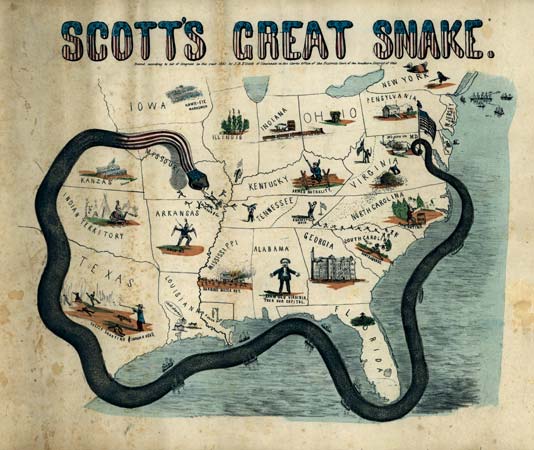The Anaconda Plan is the name applied to a U.S. Union Army outline strategy for suppressing the Confederacy at the beginning of the American Civil War. Proposed by Union general-in-chief Winfield Scott, the plan emphasized a Union blockade of the Southern ports and called for an advance doawn the Mississippi River to cut the South in two. Because the blockade would be rather passive, it was widely derided by a vociferous faction of Union generals who wanted a more vigorous prosecution of the war and who likened it to the coils of an anaconda suffocating its victim. The snake image caught on, giving the proposal its popular name.

The Mississippi River
Scott’s plan called for small bands of troops to make an aggressive move south down the Mississippi River and seize key objectives along the way. They would be part of a larger force numbering 70,000 or more but would be broken down into smaller segments for speed and would launch their attacks via amphibious assaults.
They would be trailed by a more traditional army that would secure the captured objectives along the way, with forts in New Orleans being the ultimate objective. Once these forts could be taken, the Confederacy would be cut in two and severely weakened.
When Scott first proposed this plan, the Union did not have the ships or the personnel to implement it.
The Blockade
The most important aspect of this plan would be the naval blockade of the entire south, including the Gulf of Mexico and the eastern Atlantic seaboard. If the southern states could not export cotton and other goods to Europe, they would be severely hampered financially, and this would greatly affect their ability to wage war.
Shortly after the shots were fired on Fort Sumter, Lincoln had proposed a naval blockade of the South. Although the blockade was already in place, the Navy did not yet have enough ships or men to enforce it with maximum effect. This would come later on as the war progressed.
Criticism of The Anaconda Plan
The Anaconda Plan had its critics by those who thought the war could be won quickly with a few decisive land battles in the east. They didn’t think the South had the stomach for the war and would give up quickly when faced with losses.
Although the plan was not officially adopted, President Abraham Lincoln followed it as a rough plan throughout the war and understood the importance of controlling the Mississippi even when others did not.
Many historians would argue that the Union victories on the Mississippi were more critical to the outcome of the war than the clash of the great armies in the East. It is debatable whether the blockade was critical to defeating the South, but it certainly proved to have some effect.
Though it was never fully implemented, the Anaconda Plan proved its value and regained lost credibility following the war as a plan that could have ended the war sooner.
